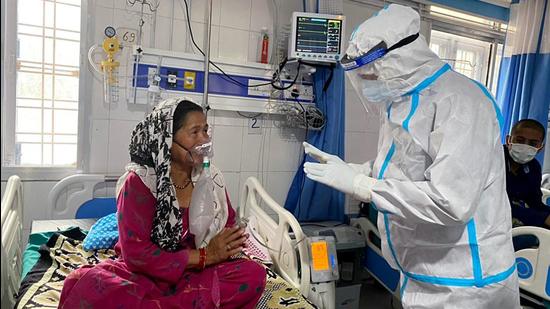Strengthening India’s district hospitals
The pandemic had brought home the costs of neglecting district hospitals. For the sake of public health, focus on them
The Covid-19 pandemic, especially the vicious second wave, has created an unprecedented burden on an already creaky health system. India needs a responsive and resilient health infrastructure to cope with the challenges posed by the virus.

At present, India has a three-level framework of healthcare. This comprises the village-or community-level primary healthcare centres (PHCs/CHCs), district-level secondary healthcare facilities in the form of district hospitals, and tertiary care premier institutes and centres of excellence with state-of-the-art facilities for specialised treatment.
The pandemic has revealed one of the weakest links in the health system — the poor infrastructure in district hospitals and their institutional neglect. The pressure on these hospitals has thrown up many worrying facts. Just take one example. Many district hospitals did not have ventilators. It was also found that hundreds of ventilators distributed through the PM Cares Fund to several district hospitals across the country were either unused or could not be operated as the facilities lacked trained critical care specialists and technicians.
Also Read | Sustaining and scaling up the response to Covid is key to saving lives
But things were not always so dire. In 1970s and 1980s, many district hospitals in the country were considered centres of excellence in various surgical and medical specialties. But predictably, many deteriorated over the years as they were unable to keep pace with the advancement in technologies and owing to lapses in timely upgradation of infrastructure.
Since the mid-1990s, the focus in healthcare shifted to the private sector and a slew of profit-generating corporate hospitals were set up largely in big cities. This had a deleterious effect on the public health system and many government and charitable hospitals became unviable and had to shut down.
Many of those who seek treatment at these high-end, tertiary medical facilities do not need to do so at all, as their ailments can easily be tackled at primary and secondary healthcare centres. In a cross-sectional study conducted by All India Institute of Medical Sciences in 2018 and published in Seizure, it was found that many epilepsy patients seeking tertiary care could actually have been provided the care they needed at district hospitals if a robust need-based referral system had been in place.
Most of these hospitals are centrally located in each district and could be hubs for referral treatment, training of health workers, supervision of peripheral facilities, as well as public health surveillance. Most of them have 100 to 500 beds that cater to anywhere between 100,000 to a million citizens a lakh in each district.
Indian Public Health Standard (IPHS) guidelines for district hospitals, first issued in 2007 by the directorate of general health services and revised in 2012, focused not only on physical infrastructure, manpower requirements, equipment norms and laboratory services at district hospitals but also emphasised capacity-building, quality assurance, quality control of processes, service delivery and compliance.
The ministry of health and family welfare followed this up in 2017 with technical and operational guidelines for strengthening district hospitals for multi-specialty care and as sites for training. These also mandated that each district hospital should also have a public health unit, an epidemiologist, an entomologist, a microbiologist, a communications officer, a district public health nursing officer and a demographer for handling health emergencies and active disease surveillance.
This provides the framework for the improvement and strengthening of district hospitals. What is now required are five crucial interventions to shore up this system.
First, the buildings of existing hospitals should be upgraded, focusing on proper design, improved infrastructure and long- lasting and replenishable supply-chain logistics without which dispensing quality care is impossible.
Second, efforts must be made to attract well-trained and dedicated staff to district hospitals by offering them opportunities for quality clinical work with assured career growth prospects. They should also be provided with proper housing and educational facilities for their children, among other incentives.
Third, technological support must be provided in the form of cloud computing, artificial intelligence for hospital information systems and disease surveillance. These will contribute to efficient management and ongoing medical education and training.
Fourth, laboratory services need to be upgraded with the provision of the latest equipment including molecular diagnostics and pathological services and periodic quality improvement audits.
Finally, it is essential to gain and sustain public confidence in district hospitals. This can be accomplished by engaging professionals with passion and empathy for their jobs, incentivising them with appropriate rewards and utilising emerging technologies.
We are, hopefully, witnessing a declining trend in the second wave of the pandemic in many states. This is the appropriate time to identify and plug existing gaps in our health system. The focal point for this should be strengthening district hospitals as they can form the foundation for a functioning and effective health system. We must act now to shore up our defences in healthcare, if we are to save people today and protect them in health crises in the future.
Rajinder K Dhamija is the head of neurology department, Lady Hardinge Medical College and SSK Hospital, New Delhi. He was, formerly, a WHO Fellow at National Institute of Epidemiology
The views expressed are personal
Continue reading with HT Premium Subscription




